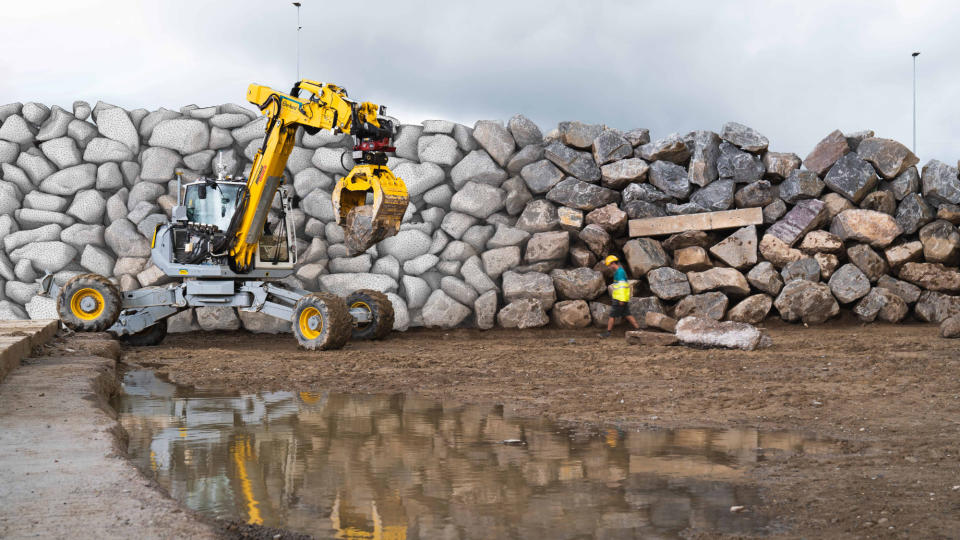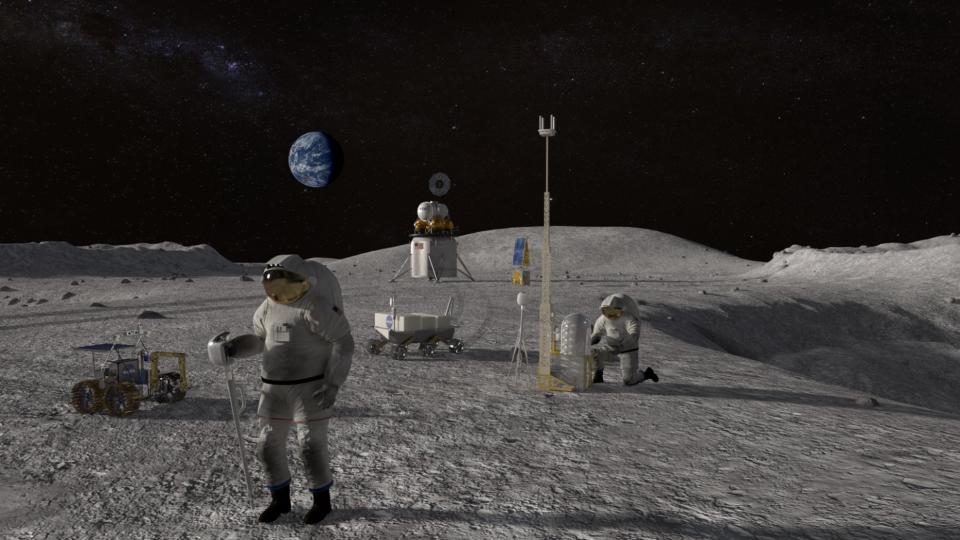When you buy through links on our articles, Future and its syndication partners may earn a commission.


An autonomous, robotic hydraulic excavator could build a dry stone wall to act as a blast shield around a launch pad on the moon, propose a team of Swiss researchers.
The excavator would make use of in situ materials (rather than the costly practice of transporting building material from Earth to the moon), collecting rocks on the lunar surface for use in a ringed wall with a radius of between 50 and 100 meters (164 to 328 feet).
“The robot would be used to both collect the boulders as well as to construct the wall,” study lead author Jonas Walther told Space.com.
Walther conducted the research for his masters thesis at ETH Zürich and now works at the Swiss company Venturi Lab, which works with other companies on lunar rover design, specializing on the wheels.
Related: There’s lots of water on the moon for astronauts. But is it safe to drink?
If humans return to the moon permanently and set up a base there, this infrastructure will need to be protected from the exhaust and debris from rockets taking off and landing. Dust, small particles and gas from rocket exhaust can all be hazardous, as was demonstrated when the Apollo 12 crew brought back the Surveyor 3 probe from Oceanus Procellarum and it was found to have been damaged by dust blown away by the Lunar Module Intrepid.
It’s also expected that the rocket exhaust from SpaceX’s giant Starship vehicle, which will be used on NASA’s Artemis 3 mission to put astronauts on the surface of the moon again, will affect the lunar environment across hundreds of meters, perhaps extending into kilometers. Hence the need for a blast shield to protect any future ground infrastructure.
Walther cites a terrestrial prototype of his envisioned lunar excavator. As described in a 2023 paper in the journal Science, a team led by Walther’s co-author, ETH Zürich’s Ryan Luke Johns, designed an autonomous robot to excavate material and use it to assemble a dry stone wall here on Earth. Their new research takes this technology and applies it to a lunar environment.
The challenges that this technology would face on the moon include the distance a vehicle would have to travel to collect enough raw material to build a blast shield, the energy required to accomplish this and the source of that energy.
However, the advantages, argue Walther and his team, greatly exceed those of other construction techniques. For one thing, a dry stone wall using boulders plucked from the lunar surface does not require the energy-intensive material-processing methods that other techniques might employ, such as heating to cement the material in place. Plus, Walther points out, dry stone walls, as primitive as they sound, can have remarkable longevity.
“Some dry stone walls on Earth have endured for thousands of years,” Walther said. And while such structures built on the moon won’t necessarily have to last quite as long as that, the vastly reduced weathering on the moon (no air, no water, no wind, only space weathering from cosmic particles) means that the only forces such a wall would have to resist would be the blasts of rockets taking off or landing. Walther’s team estimate that the pressure on the blast shield from gasses expelled by one of SpaceX’s Starship rockets would be 1,135 Pascals. This is very slight compared to the standard atmospheric pressure on Earth of 101,000 Pascals.
The time- and energy-consuming part, however, is collecting the material. Walther’s team estimate the excavator’s payload capacity to be 10 cubic meters (353 cubic feet) of boulders; to build a blast shield ring with a radius of 50 meters, a circumference of 314 meters (1,030 feet) and a height of 3.3 meters (10.8 feet) would require an estimated total of 1,000 cubic meters’ (35,314 cubic feet) worth of lunar boulders (defined as being stones larger than 25.6 centimeters, or about 10 inches).
The excavator has to roll out and find all this material on the moon itself. Walther’s team studied images of two potential locations where a lunar base might be situated, namely the Shackleton-Henson Connecting Ridge that links the craters Shackleton and Henson in the moon’s south polar region and is a possible landing site for Artemis 3, and the Aristarchus Plateau pyroclastic deposit near the notable crater Aristarchus in Oceanus Procellarum.
Based on images of these two regions taken by the Narrow Angle Camera on NASA’s Lunar Reconnaissance Orbiter, which can detect boulders down to 2 meters (6.6 feet) wide, and by employing boulder size frequency laws to estimate how many unseen smaller boulders there are (there are more smaller boulders than larger ones), Walther’s team then used an algorithm to calculate the most efficient path the excavator could take to gather up all the raw material and return it to the construction site, going back and forth multiple times. They arrived at a total distance traveled of between 776 and 880 kilometers (482 and 547 miles), although this figure will depend on caveats such as payload capacity and ease of access to material (much is expected to have gathered at the bottom of slopes, for instance).
“I agree that the distance sounds quite large at first,” said Walther, but he points out that driving such a distance is not unrealistic. “The Lunar Terrain Vehicle (LTV) being developed for Artemis, or NASA’s concept rover called Endurance, will be capable of similar distances.”
The excavator and dry stone wall would also use substantially less energy than other methods that would cement a wall instead. Walther’s team calculate that the excavator would expend between 9 and 10 gigajoules of energy in the construction of just a quarter segment of the blast shield. In comparison, cast regolith, whereby regolith (lunar dirt and rock) is heated until it melts and then poured into molds and left to cool to form shaped sections, would use 1,250 gigajoules per quarter segment. Microwave heating would be even more energy intensive, using between 6,440 and 17,500 gigajoules depending upon the density of the material. The autonomous excavator building a dry stone wall would therefore be at least two orders of magnitude less energy intensive.
This is important on the moon because an isolated lunar base would need to be energy conscious, at least to begin with. The total time estimated to build the blast shield would be about 63 Earth days, but that doesn’t include recharging times, and, if using solar power the excavator would need to go into hibernation every two weeks for lunar night, so this would double the construction time to at least 126 days. Portable recharging stations, or equipping the excavator with nuclear power in the form of a radioisotopic thermoelectric generator (RTG) of the kind the Mars rovers Curiosity and Perseverance have, but more powerful, could alleviate some of these delays.
Related: NASA may build more than one moon base for Artemis lunar missions


RELATED STORIES:
— Where will NASA set up its moon base?
— Everything you need to know about NASA’s Artemis program
— 1st map of moon water could help Artemis astronauts live at the lunar south pole
A dry stone wall might include some gaps, and Walther admits that further study is required to determine whether these gaps would be a problem in either weakening the structure or not sufficiently protecting any lunar base positioned behind the blast shield. However, his team foresee that the excavator could be even more useful on Mars, where there is a greater density of boulders across a smaller area, reducing the drive time and energy use.
The terrestrial prototype shows that a lunar version could be developed in a relatively short timescale. However, much is dependent upon the progress of NASA’s Artemis program, with Artemis 2 already delayed until September 2025 at the earliest, and Artemis 3, which would involve the first landing on the moon since Apollo 17 in 1972, having no definite timeline. Whether further missions launch beyond Artemis 3 remains unknown at this current time, but if an effort is made to develop a base on the moon’s surface, the autonomous excavator and its dry stone walls could be vital in constructing bulk structures in a hurry.
The assessment of the excavator by Walther’s team was published on June 6 in the journal Frontiers in Space Technologies.
